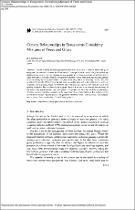JavaScript is disabled for your browser. Some features of this site may not work without it.
- ResearchSpace
- →
- Research Publications/Outputs
- →
- Journal Articles
- →
- View Item
| dc.contributor.author |
Scholes, RJ

|
en_US |
| dc.date.accessioned | 2007-02-08T09:30:39Z | en_US |
| dc.date.accessioned | 2007-06-07T10:03:18Z | |
| dc.date.available | 2007-02-08T09:30:39Z | en_US |
| dc.date.available | 2007-06-07T10:03:18Z | |
| dc.date.copyright | en_US | |
| dc.date.issued | 2003-12 | en_US |
| dc.identifier.citation | Scholes RJ. 2003. Convex relationships in ecosystems containing mixtures of trees and grass. Environmental & Resource Economics, vol. 26(4), pp 559-574. | en_US |
| dc.identifier.issn | 0924-6460 | en_US |
| dc.identifier.uri | http://hdl.handle.net/10204/1674 | en_US |
| dc.identifier.uri | http://hdl.handle.net/10204/1674 | |
| dc.description.abstract | The relationship between grass production and the quantity of trees in mixed tree-grass ecosystems (savannas) is convex for all or most of its range. In other words, the grass production declines more steeply per unit increase in tree quantity at low tree cover than at high tree cover. Since much of the economic value in savannas is ultimately derived from grass, and the main mechanism controlling the tree-grass balance is dependent on the production of grassy fuel for fires, this non-linearity has the effect of creating two savannas configurations. One has a low tree density and supports a viable grazing enterprise, while the other has dense tree cover and a frequently non-viable grazing enterprise. The non-linearity is suggested here to have two main sources: the geometry of the spatial interaction between tree root system and grasses, and the effect of differing phenology (the time course of leaf area exposure) on the acquisition of water and nutrients. The existence of the non-linearity reduces the resilience of the generally-preferred "open" configuration, and increases the resilience of the less-desirable "closed" configuration. | en_US |
| dc.format.extent | 904276 bytes | en_US |
| dc.format.mimetype | application/pdf | en_US |
| dc.language.iso | en | en_US |
| dc.publisher | Kluwer Academic Publishers | en_US |
| dc.rights | Copyright: 2003 Kluwer Academic Publishers. | en_US |
| dc.source | en_US | |
| dc.subject | Competition | en_US |
| dc.subject | Primary productivity | en_US |
| dc.subject | Resilience | en_US |
| dc.subject | Savannas | en_US |
| dc.subject | Environmental sciences | en_US |
| dc.title | Convex relationships in ecosystems containing mixtures of trees and grass | en_US |
| dc.type | Article | en_US |
| dc.identifier.apacitation | Scholes, R. (2003). Convex relationships in ecosystems containing mixtures of trees and grass. http://hdl.handle.net/10204/1674 | en_ZA |
| dc.identifier.chicagocitation | Scholes, RJ "Convex relationships in ecosystems containing mixtures of trees and grass." (2003) http://hdl.handle.net/10204/1674 | en_ZA |
| dc.identifier.vancouvercitation | Scholes R. Convex relationships in ecosystems containing mixtures of trees and grass. 2003; http://hdl.handle.net/10204/1674. | en_ZA |
| dc.identifier.ris | TY - Article AU - Scholes, RJ AB - The relationship between grass production and the quantity of trees in mixed tree-grass ecosystems (savannas) is convex for all or most of its range. In other words, the grass production declines more steeply per unit increase in tree quantity at low tree cover than at high tree cover. Since much of the economic value in savannas is ultimately derived from grass, and the main mechanism controlling the tree-grass balance is dependent on the production of grassy fuel for fires, this non-linearity has the effect of creating two savannas configurations. One has a low tree density and supports a viable grazing enterprise, while the other has dense tree cover and a frequently non-viable grazing enterprise. The non-linearity is suggested here to have two main sources: the geometry of the spatial interaction between tree root system and grasses, and the effect of differing phenology (the time course of leaf area exposure) on the acquisition of water and nutrients. The existence of the non-linearity reduces the resilience of the generally-preferred "open" configuration, and increases the resilience of the less-desirable "closed" configuration. DA - 2003-12 DB - ResearchSpace DP - CSIR KW - Competition KW - Primary productivity KW - Resilience KW - Savannas KW - Environmental sciences LK - https://researchspace.csir.co.za PY - 2003 SM - 0924-6460 T1 - Convex relationships in ecosystems containing mixtures of trees and grass TI - Convex relationships in ecosystems containing mixtures of trees and grass UR - http://hdl.handle.net/10204/1674 ER - | en_ZA |






